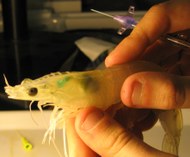Research
Research lines
Our research group studies various aspects of larviculture of aquaculture organisms, such as fish, crustaceans or molluscs.
Live food applications
Feeding the earliest live stages of many commercially farmed fish and shrimp remains a challenge as no adequate formulated feed enables to equal the performance of live feed, the most commonly used being brine shrimp Artemia and the rotifer Brachionus.
Our research on Artemia focusses on the development of applications for Artemia as live feed and the improvement of the production of brine shrimp biomass and their cysts under lab conditions but also under field condition eg in temporary habitats. For this purpose, our lab maintains a unique Artemia cyst collection. For its pivotal role in Artemia research, FAO conferred our lab in 1978 the one-of-a-kind title of "Artemia Reference Center".
Artemia genome sequencing
To further support the research on Artemia, the lab has heavily invested in the genome sequence of Artemia, an effort that has now resulted in the availability of an annotated Artemia genome (not published yet).
Microbial management
Microbial management of larviculture of aquatic organisms is of tremendous economic importance. Especially for marine organisms, mortality during the larval culture phase is high and unpredictable. This phenomenon is associated with the stochastic colonisation of the larvae by mainly opportunistic pathogenic micro-organisms, as is substantiated by the short term beneficial effects of antibiotics. In the long term, the use of antibiotics is not sustainable and needs to be replaced by alternative technologies. The lab is focussing on the development of novel techniques to control the composition of the microbial community or its activity.
Quorum sensing
A promising technique for microbial management is based on quorum sensing associated with microbial activity and on the use of organic acid (such as polyhydroxy-butyric acid or PHB) to steer the microbial community composition.
Immunostimulants, prp/prebiotics & heat shock proteins
Alternatively, it is possible to increase the robustness of the host by favourably influencing the immune system. At the moment research is focussing on the use of yeast cell wall mutants and heat shock proteins (inducers) as putative immunostimulants.
Gnotobiotic (Artemia) toolbox
In order to perform study host-microbe interactions under rigorous experimental conditions, gnotobiotic culture conditions are developed for the target organisms under study, allowing for total control over the microbial community composition. This experimental approach has been proven successful, allowing to look at in vivo bacterial gene expression and host gene expression in an unequivocal way.
